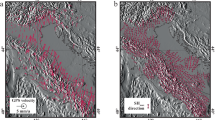Abstract
—The size distribution of earthquakes has been investigated since the early 20th century. In 1932 Wadati assumed a power-law distribution n(E) = kE −w for earthquake energy E and estimated the w value to be 1.7 ∼ 2.1. Since the introduction of the magnitude-frequency relation by Gutenberg and Richter in 1944 in the form of log n(M) = a−bM, the spatial or temporal variation (or stability) of b value has been a frequently discussed subject in seismicity studies. The log n(M) versus M plots for some data sets exhibit considerable deviation from a straight line. Many modifications of the G-R relation have been proposed to represent such character. The modified equations include the truncated G-R equation, two-range G-R equation, equations with various additional terms to the original G-R equation. The gamma distribution of seismic moments is equivalent to one of these equations.¶In this paper we examine which equation is the most suitable to magnitude data from Japan and the world using AIC. In some cases, the original G-R equation is the most suitable, however in some cases other equations fit far better. The AIC is also a powerful tool to test the significance of the difference in parameter values between two sets of magnitude data under the assumption that the magnitudes are distributed according to a specified equation. Even if there is no significant difference in b value between two data sets (the G-R relation is assumed), we may find a significant difference between the same data sets under the assumption of another relation. To represent a character of the size distribution, there are indexes other than parameters in the magnitude-frequency distribution. The η value is one of such numbers. Although it is certain that these indexes vary among different data sets and are usable to represent a certain feature of seismicity, the usefulness of these indexes in some practical problems such as foreshock discrimination has not yet been established.
Similar content being viewed by others
Author information
Authors and Affiliations
Additional information
Received June 27, 1998, accepted revised/accepted November 11, 1998
Rights and permissions
About this article
Cite this article
Utsu, T. Representation and Analysis of the Earthquake Size Distribution: A Historical Review and Some New Approaches. Pure appl. geophys. 155, 509–535 (1999). https://doi.org/10.1007/s000240050276
Published:
Issue Date:
DOI: https://doi.org/10.1007/s000240050276




